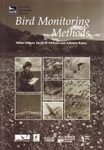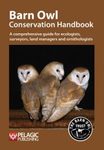![Marked Individuals in the Study of Bird Population Marked Individuals in the Study of Bird Population]()
Click to have a closer look
About this book
Contents
Related titles
About this book
The study of bird populations today relies heavily on the use of marking individuals, and then sampling the population, by radio-tracking, live recapture, or recovery of dead birds. Marking is usually by ringing, with over 4 million birds ringed each year in Europe alone. This book provides a comprehensive review of specific methods, models and software for analyzing data from individually marked animals.
Contents
Instinctive statistics, George M. Jolly. Part 1 Modelling complex effects in recoveries, live recaptures and radio-tracking data: testing the significance of individual- and cohort-level covariates in animal survival studies, John R. Skalski et al; flexibility in survival analysis from recapture data - handling trap-dependence, Roger Pradel; the flexibility of GLIM analyses of multiple recapture or resighting data, Richard M. Cormack; estimating survival of radio-tagged birds, Christine M. Bunck and K.H. Pollock; extensive parameterization of survival models for recovery data analysis, Johani Rinne et al; merging recoveries and recaptures to estimate survival probabilities, Terry B. Oatley and L.G. Underhill; evaluation of radio tagging marking and sighting estimators of population size using Monte Carlo simulations, Gary C. White. Part 2 Survival analysis in practice: combining mark-recapture data sets for small Passerines, Will J. Peach; modelling the survival rates of Passerines ringed during the breeding season from national ringing and recovery data, Stephen R. Baillie and N. McCulloch; approaches to estimation of survival in two arctic-nesting goose species, Michael C. Bell et al; modelling Raptor populations - to ring or to radio-tag?, Robert E. Kenward; a comparison of survival rate estimates from live recaptures and dead recoveries of lesser show geese, Charles M. Francis and Fred Cooke; the influence of capture-recapture methodology on the evolution of the North American banding program, John Tautin. Part 3 Merging different sources of information: a theory for combined analysis of ring recovery and recapture data, Kenneth P. Burnham; on boundary estimation in ring recovery models and the effect of adding recapture information, Edward E. Catchpole et al; survival rate estimation in the presence of tag loss using joint analysis of capture-recapture and resighting data, James D. Nichols and J.E. Hines; the "robust" capture-recapture design allows components of recruitment to be estimated, Kenneth H. Pollock et al. Part 4 Recruitment and dispersal: estimating migration rates using tag-recovery data, Carl J. Schwarz; the estimation of exchanges among populations or subpopulations, James D. Nichols et al; the components of local recruitment, Jean Clobert et al; challenges in the analysis of recruitment and spatial organization of populations, Fred Cooke and C.M. Francis; a model for mark-recapture data allowing for animal movement, Bryan F.J. Manly and C. Chatterjee; on the role of ringing schemes in the measurement of dispersal, Arie van Noordwijk. Part 5 Survival in relation with habitat: testing hypotheses about the relationship of habitat to animal survivorship, Michael J. Conroy; survival and habitat utilization - a case for compositional analysis, Nicholas J. Aebischer et al. Part 6 Reviews.
Customer Reviews





















![Ageing & Sexing of Migratory East Asian Passerines [English / Chinese]](http://mediacdn.nhbs.com/jackets/jackets_resizer_medium/25/250760.jpg?height=150&width=115)












